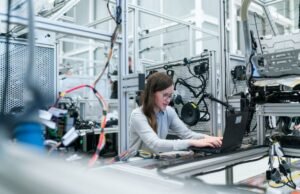Artificial Intelligence Models
Artificial Intelligence (AI) models are the backbone of modern technology, playing a crucial role in various industries and daily life. These models are designed to mimic human intelligence and have the ability to learn, reason, and perform tasks with minimal human intervention. From self-driving cars to virtual assistants, AI models are transforming the way we live and work.
Key Takeaways:
- Artificial Intelligence (AI) models emulate human intelligence for various applications.
- AI models learn, reason, and perform tasks with minimal human intervention.
- They have significant impacts across various industries, enhancing efficiency and productivity.
- Common applications of AI models include self-driving cars, virtual assistants, and image recognition.
With the exponential growth of data and computational power, AI models have gained immense popularity in recent years. These models leverage complex algorithms and statistical techniques to analyze vast amounts of data and make informed decisions. **Deep learning** algorithms, inspired by the structure and function of the human brain, have revolutionized AI models by enabling them to learn and generalize from massive datasets. *Their ability to extract meaningful patterns from unstructured data sets them apart from traditional machine learning approaches.*
AI models excel in various domains such as image and speech recognition, natural language processing, and strategic decision-making. In image recognition, models employ **convolutional neural networks (CNNs)** that can accurately classify and detect objects within images. With the development of **recurrent neural networks (RNNs)**, AI models can understand and generate human-like speech, enabling applications like voice-controlled virtual assistants.
Applications of AI Models:
- Self-driving cars: AI models analyze sensor data and make real-time decisions to navigate roads safely.
- Virtual assistants: AI models understand and respond to voice queries, performing tasks on user command.
- Image recognition: AI models can accurately identify objects, people, or scenes within an image.
- Financial analysis: AI models assist in predicting market trends and analyzing investment portfolios.
| AI Models | Applications |
|---|---|
| Reinforcement Learning | Robotics, gaming, autonomous systems |
| Natural Language Processing (NLP) | Chatbots, language translation, sentiment analysis |
The success of AI models heavily relies on the availability of large and diverse datasets for training. These datasets are used to expose the model to various scenarios and help it generalize better. An **interesting fact** is that ImageNet, a popular dataset for image classification models, contains over 14 million labeled images spanning 1,000 different classes.
| Dataset | Size |
|---|---|
| MNIST (handwritten digits) | 60,000 training images, 10,000 test images |
| COCO (common objects in context) | 328,000 images, 2.5 million object instances |
As AI models become more sophisticated and prevalent, ethical considerations come to the forefront. **Bias** and fairness in AI decision-making processes pose challenges and require continuous monitoring and improvement. Organizations and researchers are actively working to develop frameworks and guidelines to address these concerns and ensure transparent and accountable AI applications.
Challenges and Future Directions:
- Ensuring ethical and unbiased AI decision-making.
- Continued advancement in AI model interpretability and explainability.
- Augmenting human capabilities rather than replacing human workers.
- Robust cybersecurity measures to protect AI models from attacks.
Artificial Intelligence models have revolutionized the way we interact with technology and have the potential to shape the future of various industries. The advancements in AI models are continually evolving, paving the way for exciting possibilities and transforming the world we live in.

Common Misconceptions
AI Models and their Misunderstandings
Artificial Intelligence (AI) models are widely discussed and celebrated in today’s world, but there are several common misconceptions surrounding them. Let’s address some of these misconceptions:
Misconception 1: AI Models Can Think and Make Decisions Like Humans
Contrary to popular belief, AI models cannot think or make decisions like humans do. They are essentially algorithms that are designed to process large amounts of data to identify patterns and make predictions based on those patterns. They lack consciousness, understanding, and reasoning abilities that humans possess.
- AI models primarily rely on statistical analysis rather than intuitive reasoning.
- AI models do not possess emotions or subjective experiences like humans.
- AI models can only provide outputs based on the input data and their training algorithms.
Misconception 2: AI Models Will Replace Humans in Most Jobs
While AI models have the potential to automate certain tasks and industries, they are unlikely to completely replace humans in most jobs. AI models excel at performing repetitive, data-driven tasks, but they still lack the adaptability, creativity, and complex decision-making capabilities that humans possess.
- AI models often rely on human intervention and supervision for decision-making and critical thinking tasks.
- AI models typically require constant training and maintenance by human experts.
- AI models are more useful as complementary tools to enhance human productivity rather than complete replacements in many job roles.
Misconception 3: AI Models Are Completely Objective
AI models are often assumed to be completely objective and free from bias. However, this is not the case. AI models are trained using data which can sometimes be biased or incomplete, leading to biased outcomes.
- AI models learn from historical data, which can reflect the biases present in society.
- AI models can inadvertently perpetuate existing biases and discriminations.
- AI models’ objectivity heavily depends on the quality and diversity of the data they are trained on.
Misconception 4: AI Models Are Perfect and Always Accurate
AI models are not infallible and can make mistakes, just like any other technology. Despite their remarkable capabilities, AI models are subject to errors, especially when confronted with unusual or novel situations.
- AI models can struggle with unfamiliar or insufficient data.
- AI models may exhibit biases or errors due to limitations in their training or design.
- AI models require ongoing validation and testing to ensure accuracy and reliability.
Misconception 5: AI Models Will Exceed Human Intelligence
Although AI models have achieved impressive feats, such as defeating human champions in board games, they are unlikely to surpass the overall intelligence of humans. The human mind possesses a level of intuition, creativity, and adaptability that AI models are still far from replicating.
- AI models lack common sense reasoning and understanding of complex contexts.
- AI models struggle with tasks that involve abstract thinking or require broad knowledge and experience.
- AI models cannot replicate the emotional and social intelligence exhibited by humans.

Overview of Artificial Intelligence Models
Artificial intelligence models are transforming various industries by simulating human-like intelligence in machines. These models rely on complex algorithms, extensive data sets, and advanced computing power to analyze information, make predictions, and automate tasks. This article explores ten different aspects of artificial intelligence models and their applications.
1. Deep Learning Algorithms in Image Recognition
Deep learning algorithms have revolutionized image recognition tasks. Through numerous layers of neural networks, these models analyze and classify images with incredible accuracy. For example, a deep learning model can identify objects in images for autonomous vehicles, medical diagnostics, or facial recognition.
2. Natural Language Processing for Text Analysis
Natural language processing models enable machines to understand and interpret human language. These models can be used for sentiment analysis, entity recognition, language translation, and chatbots that simulate human conversation. They enhance communication and augment human productivity.
3. Reinforcement Learning for Autonomous Systems
Reinforcement learning models learn from trial and error to maximize rewards in a given environment. These models are ideal for training autonomous systems, such as self-driving cars or robot arms. They enable machines to make intelligent decisions and adapt to dynamic situations.
4. Fraud Detection Using Machine Learning
Machine learning models can analyze large volumes of data to detect fraudulent activities. By learning patterns and anomalies, these models help financial institutions, e-commerce platforms, and cybersecurity systems identify potential fraud and take preventive measures.
5. Predictive Analytics for Sales Forecasting
Predictive analytics models use historical data to forecast future outcomes. In sales forecasting, these models can analyze past sales data, market trends, and customer behavior to predict future sales, optimize inventory levels, and plan marketing strategies.
6. Recommendation Systems for Personalization
Recommendation systems use collaborative filtering or content-based filtering techniques to tailor personalized recommendations to users. These models are prevalent in e-commerce platforms, streaming services, and social media, enhancing user experience and engagement.
7. Generative Adversarial Networks for Creative Applications
Generative adversarial networks (GANs) consist of a generator and a discriminator network that work together. GANs can create realistic images, generate music, or synthesize text that closely resembles human-created content. These models offer exciting possibilities in creative industries.
8. Sentiment Analysis in Social Media Monitoring
Sentiment analysis models analyze social media posts and determine the sentiment expressed by users, such as positive, negative, or neutral. Organizations use these models for brand monitoring, reputation management, and market research to understand public opinions.
9. Speech Recognition for Voice Commands
Speech recognition models convert spoken language into written text and enable voice-controlled interactions. These models power virtual assistants like Siri, Alexa, and Google Assistant, making it easier for users to perform tasks, search for information, and control smart devices.
10. Object Detection for Surveillance Systems
Object detection models identify and track objects within images or video streams. They find applications in surveillance systems, traffic monitoring, and object recognition. These models enhance security and can automate certain tasks, reducing human effort.
As artificial intelligence models continue to advance, they have the potential to revolutionize industries and change the way we interact with technology. From image recognition to speech synthesis, these models offer exciting opportunities and challenges. The future holds immense possibilities as we further refine and explore the capabilities of artificial intelligence models.
Frequently Asked Questions
What are artificial intelligence models?
Artificial intelligence (AI) models are algorithms or systems designed to simulate intelligent behavior by machines. These models use complex mathematical techniques to learn and make decisions, often mimicking human cognitive abilities.
How do artificial intelligence models work?
AI models are typically trained on large datasets to learn patterns and make predictions or decisions. They use techniques such as machine learning, deep learning, or reinforcement learning to process information and improve over time.
What types of applications can artificial intelligence models be used for?
AI models have a wide range of applications, including natural language processing, computer vision, speech recognition, autonomous vehicles, recommendation systems, and much more. They can be used to automate tasks, enhance decision-making processes, and improve overall efficiency in various domains.
What are the challenges in developing artificial intelligence models?
Developing AI models involves several challenges, including acquiring and preprocessing large datasets, designing appropriate model architectures, addressing issues of bias and fairness, optimizing performance and scalability, and ensuring robustness and interpretability of the models.
How can artificial intelligence models be evaluated for performance?
AI models are evaluated based on various metrics, depending on the specific task they are designed for. These metrics could include accuracy, precision, recall, F1 score, mean squared error, or other task-specific measures. Cross-validation and testing on separate datasets are commonly used evaluation techniques.
What are the ethical considerations in using artificial intelligence models?
There are several ethical considerations associated with the use of AI models. These include issues of privacy, transparency, accountability, and potential biases in the data or decision-making process. It is important to ensure that AI models are used responsibly and do not lead to discriminatory or harmful outcomes.
Can artificial intelligence models be explained or interpreted?
Interpreting AI models can be challenging, especially for complex models such as deep neural networks. However, techniques such as feature importance analysis, saliency maps, or layer visualization can provide insights into how the models make decisions. Model explainability is an active research area in AI.
Are artificial intelligence models capable of creativity?
While AI models can generate outputs that appear creative, they are currently limited to what they have been trained on. AI models do not possess consciousness or true creativity like humans. However, they can generate novel solutions or outputs based on the patterns they have learned from data.
What are the limitations of artificial intelligence models?
AI models have limitations such as being data-dependent, lack of common sense reasoning, vulnerability to adversarial attacks, and difficulties in handling unforeseen scenarios. They require large amounts of data for training and may not generalize well to entirely new situations.
What is the future of artificial intelligence models?
The future of AI models is promising, with advancements in areas such as explainable AI, federated learning, reinforcement learning, and transfer learning. As technology progresses, AI models are expected to become more capable, adaptable, and integrated into various aspects of our lives.




